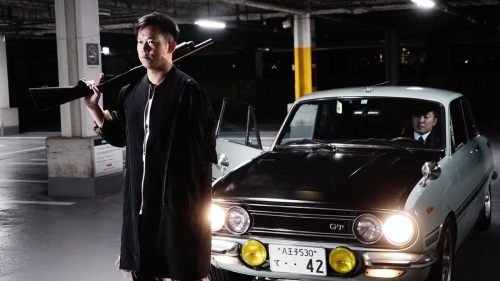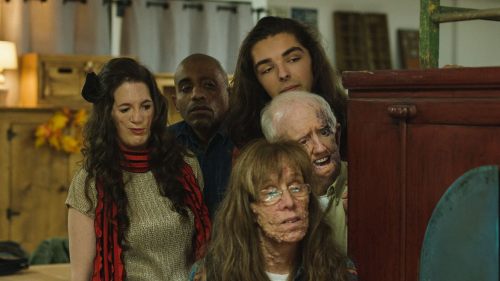Fantastic Fest Review: KOKO-DI KOKO-DA Is The Feel-Bad Movie Of The Year
Trauma: it wrecks all it touches, wrecks the people they touch, and keeps on wrecking until everything's wrecked. It constantly finds new pain to unearth, often at the most unexpected and inopportune moments, and even when it’s not actively hurtful, it’s always there, in the background, lurking in wait for its next opportunity to strike. Fertile ground for filmmakers, then.
Koko-Di Koko-Da deals with its central characters’ trauma in a range of innovative ways, starting with depicting the unique and crushing trauma itself. When their daughter Maja has an allergic reaction to some shellfish, Elin and Tobias worry briefly, but it's only when they get complacent and go to sleep that she actually dies. Maja’s death isn’t entirely their fault, exactly, but they’re fully set to blame themselves - and ultimately, that's what matters more to one's psyche. Forever, then, are they doomed to go over it and over it in their heads, as the film descends into a nightmarish time-looped cycle of death.
Elin and Tobias don’t repeat the day of Maja’s death, however. They don’t get a chance to change their actions, a la Groundhog Day. They don’t even get to repeat an entire 24-hour period. Instead, they repeat a single night, some time after the incident, in which they drive out into the forest, set up a tent, and get a few hours sleep before being brutally and gleefully murdered by a trio of bizarre wandering psychopaths. Again, and again, and again, finishing each time on a bleak aerial view of the carnage.
This isn’t a science fiction film. There’s only faint awareness on the characters’ part as to the time loop; no effort to consciously escape it. Some events change from loop to loop, but they only really affect the ways in which they get murdered. The murders themselves are inevitable for Elin and Tobias, as are misery, self-loathing, and torment, all rendered physical in the sadistic ways they're tormented and killed. Each successive death is more unpleasant and humiliating than the last, and the relentlessness of the cycle truly places the audience in their endlessly destructive mental state.
What makes their deaths so impactful is the way in which they seem both random and inevitable. They’re executed each time by the same three people: a jolly old circus barker; a lanky, long-haired, bushy-eyebrowed woman; and a portly giant, almost always seen carrying a dead dog. They’re additionally accompanied by an attack dog that eagerly contributes to the killing. These three figures bear such specificity and universality alike, they could easily be passed off as centuries-old folkloric characters, spiritual heralds of death or punishment - and yet, director Johannes Nyholmt created them from whole cloth for the film. Coupled with an eerie (real-life) nursery rhyme that choruses over each death cycle, the whole thing feels like the darkest of fairy tales.
Koko-Di Koko-Da also experiments formally; a pair of narrative bridging sequences take the form of shadow-puppet animation, telling the family’s story metaphorically through silhouetted animals and music. These complete stylistic left-turns can leave much of the audience befuddled, but if you engage with their emotional storytelling, they’re extraordinarily powerful, expressing the characters’ psychological journeys in a manner far more efficient and raw than a straight live-action treatment. Achingly beautiful and almost child-like, as if Maja were telling her parents’ story from beyond the grave, they’re a stark contrast to the matter-of-fact horror that fills much of the rest of the running time - and that’s why they’re absolutely vital.
By the end of the film, the cycle has inevitably been broken - if only to give it some sort of structural closure. Or has it? There’s little concrete indication Elin or Tobias have fully come to terms with their grief and self-loathing, and time and time again we’ve seen Tobias leave Elin for dead in order to save his own skin (Force Majeure fans, take note). Neither of our protagonists come across as particularly good people, but it’s easy to judge them from our comfortable cinema chairs. The process of grief is destructive not just to ourselves but to those we interact with, and Koko-Di Koko-Da illustrates that with all the pain, pathos, and incongruous dark humour you’d expect.
Koko-Di Koko-Da is not a crowd-pleaser. Given its stylistic and tonal shifts, its heavy emphasis on metaphor, and its utterly brutal loop of grief, cowardice, blame, cruelty, and murder, it’s almost guaranteed to spark walk-outs. But it’s also a triumphantly unique work of cinematic art, telling a universal story in genuinely innovative ways that continue to burrow into the mind long after the film rolls to a close. If you have the fortitude to get through a feel-bad movie of this strangeness and magnitude, it’s an easy recommendation, and maybe even the best feel-bad movie of the year.



